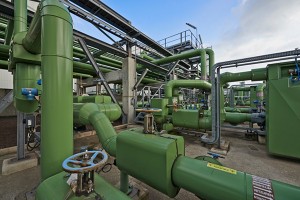An overview of biogas
Biogas typically refers to the mixture of gases produced by the breakdown of organic matter by biological organisms in an oxygen-free environment. The process is referred to as anaerobic digestion. Biogas can be produced from raw materials such as agricultural waste, manure, municipal waste, plant material, sewage, green waste or food waste. Some types of organic matter break down more easily than others. Generally, more easily digestible organic matter produces a higher biogas yield. Biogas is primarily composed of methane (CH4), carbon dioxide (CO2) and small amounts of hydrogen sulfide, siloxanes and water vapor.
Biopropane
Currently, commercially available propane (C3H8) is produced by the exploration and production of petroleum and natural gas. Around the world, several companies are developing methods to produce biopropane from a variety of feedstocks. To date, none of these processes has been deployed commercially.
Researchers at MIT announced in 2007 that they had developed a process for the production of biopropane from corn or sugarcane, which employed supercritical fluids. A startup company called C3 BioEnergy was formed to commercialize the process. The C3 BioEnergy process was never deployed commercially.
A team of scientists at Imperial College London announced in 2014 that it had modified Escherichia coli bacteria to produce renewable propane. However, the amounts were 1,000 times less than what would be needed for commercial applications. Patrik Jones, from the Department of Life Sciences, suggests that a commercially viable biological pathway might be achieved in five to 10 years.
In October 2014, Neste announced its intention to produce biopropane at its renewable diesel plant in Rotterdam, in the Netherlands. Propane would be separated from the NExBTL process sidestream waste gases. The bioLPG produced by Neste will be distributed via SHV Energy in Europe under the Calor brand. Production is projected to begin between late 2016 or early 2017.
Biochemists from the University of Manchester published research in April 2015 describing improved synthetic pathways for the biosynthesis of propane. Their research utilized CoA intermediates that are derived from clostridial-like fermentative butanol pathways. This provided a significant improvement over the earlier results obtained via the FAS pathway at the Imperial College London in 2014.
Alkcon Corp. announced that it reached an exclusivity agreement with Flogas Group in July 2015. The agreement gives Flogas the exclusive right to market and sell Alkcon methane-to-propane gas conversion equipment throughout most of Western Europe. Flogas intends to produce biopropane at various biogas production sites beginning in mid-2016. Flogas Group is a subsidiary of DCC Energy.
Being molecularly identical, biopropane is a drop-in replacement for traditional propane. It can be used in all applications, with all equipment designed to use propane as a fuel without modification.
But unlike traditional propane, biopropane is, by definition, a renewable source of energy. Biopropane has a higher caloric and monetary value than biomethane. It could easily be transported on land and sea at moderate pressures. There is a growing interest in propane as a transportation fuel. Several European countries are considering subsidies for the production of biopropane.
Biomethane
Biogas produced via anaerobic digestion usually contains between 50 and 75 percent methane gas. Once biogas is scrubbed of carbon dioxide and other impurities, the remaining product is generally composed of up to 95 percent methane gas. Methane produced in this matter is often referred to as “biomethane” to distinguish it from natural gas produced via oil and gas exploration and production. Unlike commercial natural gas, biomethane is renewable.
Methane is a potent greenhouse gas. Pound for pound, the comparative impact of methane on climate change is more than 20 times greater than carbon dioxide over a 100-year period. Increased government regulatory action is being taken to limit the release of methane into the atmosphere from flaring and agricultural operations.
Like natural gas, biomethane is difficult to transport economically unless high-pressure gas pipeline infrastructure exists. It is generally consumed near the point of production as a heating fuel, in a cogeneration plant or used as a compressed gas transportation fuel.
BioDME
Dimethyl ether (DME) is a non-toxic gas. It becomes a liquid at moderate pressures and has similar properties as LP gas. DME has many applications, such as an aerosol propellant or as a fuel for heating, power generation and transportation.
DME (CH3OCH3) can be produced from natural gas, coal or biomass. DME has potential as an ideal fuel for diesel engines and for ultra low exhaust emissions and reduced noise levels. California recently legalized the use of DME for use as motor vehicle fuel. The Environmental Protection Agency approved biogas-based DME for inclusion under the Renewable Fuel Standard and made it eligible for Renewable Identification Numbers credits.
Investigations have shown that DME produced via biomass gasification and catalytic synthesis has very high well-to-wheel energy efficiency.
Source: Alkcon Corp.

















